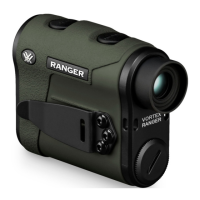17 16
RANGER
®
13 0 0
LASER RANGEFINDER
Rangefinding Tips
Laser rangefinders work by emitting a brief pulse of light aimed at a
target object. Distance is determined by the amount of time taken
for the light to emit and return to the laser’s internal receiver. A
laser’s ability to read range can be affected by many things—mostly
relating to the target objects. Under ideal conditions, the Ranger
®
1300 can be expected to range a large reflective object out to
1300 yards and deer-sized game out to 600 yards.
• Light colors will usually reflect the laser pulse better than
dark ones. An exception would be snow, which can be difficult
to range.
• Shiny, reflective surfaces will usually reflect the laser pulse better
than dull, textured surfaces. Animal hair will not reflect as well as
a hard surface.
• Ranging while under cloud cover can improve laser performance
compared to ranging while under bright sunny conditions.
• Solid objects, such as rock piles, will reflect the laser pulse
better than less dense items such as bushes.
• Flat surfaces perpendicular to the laser pulse will reflect better
than curved surfaces or surfaces angled in relation to laser pulse.
• Ranging over water can sometimes cause false reflections
and readings.
• At longer distances, larger objects will be easier to range than
small objects.
• If you are having difficulty ranging an animal or object, try ranging
a different nearby object or use the Scan feature to pan back and
forth while watching for changes in range number.
FCC Requirements
The user’s manual or instruction manual for an intentional or
unintentional radiator shall caution the user that changes or
modifications not expressly approved by the party responsible for
compliance could void the user’s authority to operate the equipment.
NOTE: This equipment has been tested and found to comply with the
limits for a Class B digital device, pursuant to part 15 of the FCC
Rules. These limits are designed to provide reasonable protection
against harmful interference in a residential installation. This
equipment generates, uses and can radiate radio frequency energy
and, if not installed and used in accordance with the instructions,
may cause harmful interference to radio communications. However,
there is no guarantee that interference will not occur in a particular
installation. If this equipment does cause harmful interference to
radio or television reception, which can be determined by turning the
equipment off and on, the user is encouraged to try to correct the
interference by one or more of the following measures:
• Reorient or relocate the receiving antenna.
• Increase the separation between the equipment and receiver.
• Connect the equipment into an outlet on a circuit different from
that to which the receiver is connected.
• Consult the dealer or an experienced radio/TV technician for help.

